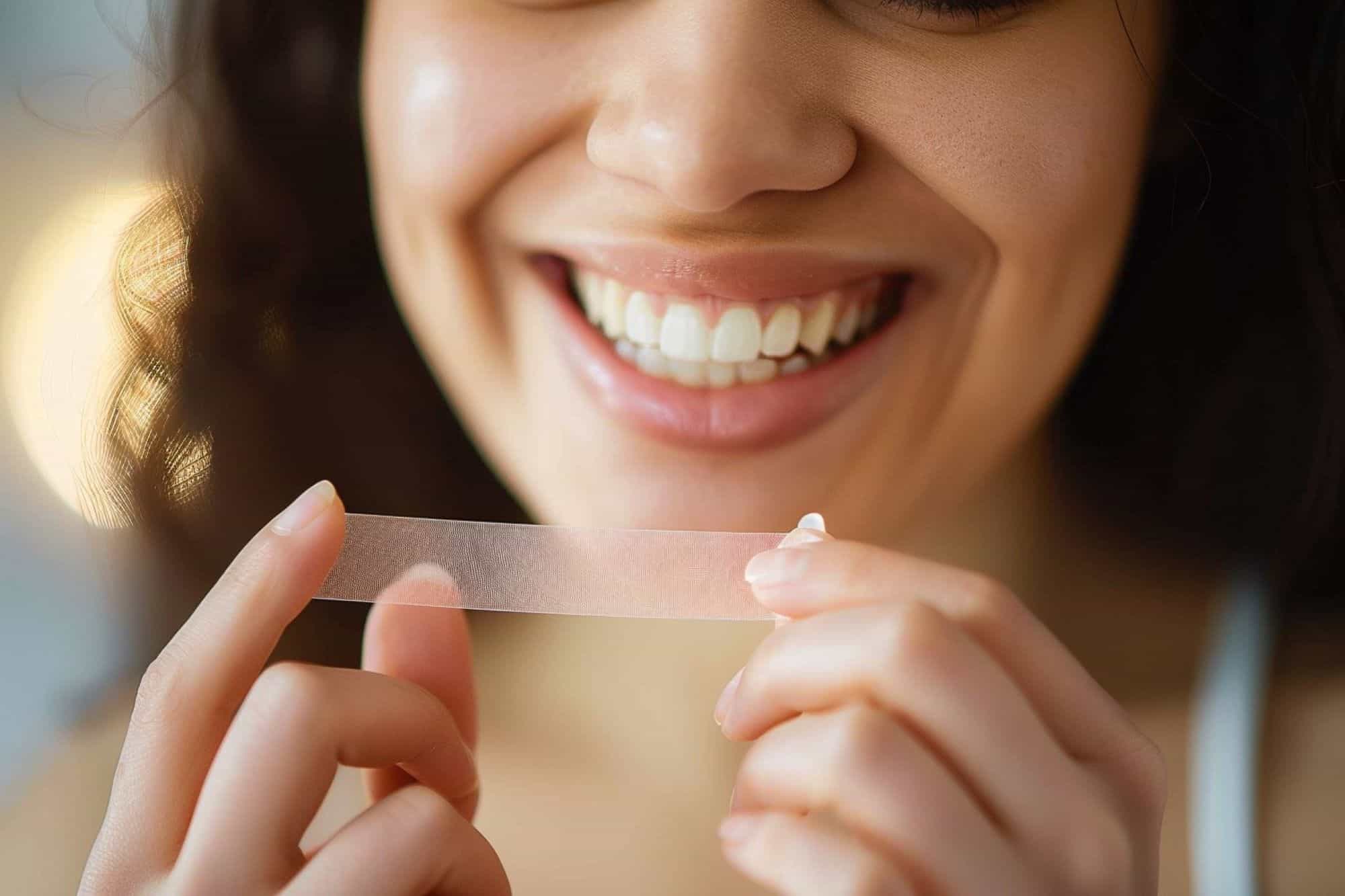Welcome to our discussion on teeth whitening strips, a popular choice for brightening smiles conveniently at home. As many in Naperville seek affordable dental solutions, it’s crucial to consider both the benefits and the risks associated with these products. Let’s explore how they work, their safety, and best practices to ensure your dental health remains a priority.
How Do Teeth Whitening Strips Work?
Teeth whitening strips are thin, flexible pieces of plastic coated with a whitening gel that contains hydrogen peroxide or carbamide peroxide. When applied to the teeth, the active ingredients in the gel work to bleach surface stains and discoloration.
The whitening agent penetrates the outer layer of the teeth, known as enamel, to reach the stains embedded below the surface. The peroxide-based gel breaks down these stains, leaving the teeth looking whiter and brighter.
This process is generally safe when directions are followed correctly, but it’s essential to understand that not all discolorations can be addressed with strips. Intrinsic stains—those that come from within the tooth—might not respond well to this form of whitening.
Main Active Ingredients
Hydrogen Peroxide: Most commonly used for its effective whitening properties, it helps remove surface stains and can brighten the enamel with repeated use.
Carbamide Peroxide: Sometimes used as an alternative to hydrogen peroxide, it works similarly but breaks down into hydrogen peroxide and urea, with a generally slower release, making it less potent but gentler on the teeth.
The Appeal of Whitening Strips
Whitening strips are immensely popular, mainly due to their accessibility and ease of use. You can find them in most pharmacies and grocery stores in Naperville, and they’re often seen as a first step in cosmetic dentistry due to their affordability compared to professional treatments.
… often seen as a first step in cosmetic dentistry due to their affordability…
Convenience and Affordability
One of the biggest draws is that you can use these strips at home, on your schedule. There’s no need to make dental appointments or spend hours in a dentist’s chair. A typical treatment involves applying the strips daily for about two weeks, though the duration can vary based on the brand and the desired whiteness level.
Effectiveness for Surface Stains
Teeth whitening strips are particularly effective at removing extrinsic stains—those caused by coffee, tea, wine, smoking, and other similar surface-staining habits. This makes them a valuable tool for those looking to brighten their smile quickly for an upcoming event or to boost their confidence.
Potential Risks and Side Effects
While teeth whitening strips offer a convenient way to brighten your smile, it’s essential to be aware of the potential risks and side effects that can arise from their use. Understanding these can help you make informed decisions and use these products safely.
Enamel Damage
One of the most significant concerns with the prolonged or incorrect use of whitening strips is the potential for enamel damage. The active ingredients, primarily hydrogen peroxide, can cause the enamel to weaken if the strips are left on too long or used too frequently. This weakening can lead to increased tooth sensitivity and make your teeth more susceptible to decay.
Tooth Sensitivity
Many users experience increased tooth sensitivity during and after the treatment. This sensitivity typically occurs because the whitening agent penetrates the enamel and exposes the dentin layer, which is closer to the nerve of the tooth. Sensitivity usually diminishes a few days after completing the treatment, but for some, it can be quite discomforting.
Uneven Whitening
Teeth whitening strips may also result in uneven whitening. This happens because the strips may not cover each tooth entirely and uniformly, especially if teeth are misaligned. As a result, some parts of your teeth might become whiter than others, leading to a patchy appearance.
Gum Irritation
Another common side effect is irritation of the gums. The bleaching agent can sometimes come into contact with gum tissue during the application, causing redness and irritation. Although this is usually temporary, it can be uncomfortable.
Recent Study Findings
Recent studies have shown that whitening products can affect the collagen in dentin, the layer beneath the enamel. The breakdown of collagen can impact the integrity and health of teeth over time, although the long-term consequences of this are still being studied.
Tips for Using Teeth Whitening Strips Safely
To use teeth whitening strips safely, follow these tips:
- Read the instructions carefully and follow them closely.
- Do not use the strips for longer than recommended or more frequently than instructed.
- If you experience any sensitivity or irritation, stop using the strips and consult your dentist.
- Do not use the strips if you have any cavities or gum disease.
- Consider using products with lower concentrations of hydrogen peroxide or carbamide peroxide to reduce the risk of enamel damage and sensitivity.
Alternatives to Whitening Strips
While teeth whitening strips are popular, there are other methods available that might be more suitable based on your dental health, budget, and preferences. Here are some effective alternatives to consider:
Professional In-Office Whitening
Speed and Efficacy: This method provides immediate results, often within an hour, and uses stronger bleaching agents than those available over-the-counter, making it more effective for stubborn stains.
FACT
Professional whitening minimizes the risk of gum irritation and enamel damage as it is performed under controlled conditions.
Custom-Fitted Whitening Trays
Personalized Treatment: Tailored to fit your teeth precisely, these trays ensure that the whitening agent is evenly distributed across all teeth, reducing the risk of uneven whitening.
At-Home Convenience: Once you receive your custom trays from your dentist in Napervile, you can use them at home, providing a balance between effectiveness and convenience.
Whitening Toothpaste and Rinses
Mild Whitening: These products contain abrasive elements or small amounts of bleaching agents that can help remove surface stains. They are less aggressive than whitening strips and are suitable for regular use.
Daily Use: Whitening toothpaste and rinses can be incorporated into your daily oral hygiene routine to maintain a whiter smile.
Natural Methods
Baking Soda and Hydrogen Peroxide: A paste made from baking soda and hydrogen peroxide can offer mild whitening effects. However, these should be used sparingly to avoid damaging the enamel.
Oil Pulling: Using coconut oil or similar oils, this traditional remedy can improve oral hygiene and might slightly reduce staining.
Choosing the right whitening method involves considering your dental health, the cause of your discoloration, and how quickly you want results. Consulting with a dentist can help you select the best option tailored to your needs.
Addressing Common Concerns
Are teeth whitening strips safe for all users?
Generally, whitening strips are safe when used as directed. However, people with sensitive teeth, gum disease, or damaged enamel should consult a dentist before use.
How often can I use whitening strips without damaging my teeth?
It is typically recommended to use whitening strips not more than twice a year to avoid overbleaching and damaging the enamel. Always follow the specific guidelines provided by the product manufacturer.
What should I do if I experience sensitivity or discomfort?
If you experience sensitivity, consider using a toothpaste designed for sensitive teeth, reduce the frequency of whitening treatments, or consult with your dentist in Naperville for other suitable options.
Can whitening strips affect dental restorations like fillings and crowns?
Whitening strips do not change the color of dental restorations such as fillings and crowns. Only natural teeth will whiten, which may result in color discrepancies.
Are there any long-term effects I should be aware of?
When used appropriately, there are no significant long-term effects. However, misuse can lead to enamel damage and increased tooth sensitivity.
Conclusion
Teeth whitening strips offer a convenient and cost-effective way to brighten your smile, but it’s important to use them wisely. By understanding their benefits and risks, adhering to safe usage guidelines, and exploring suitable alternatives, you can achieve a healthier, whiter smile. Remember, the best approach to teeth whitening is one that considers your overall dental health, so consulting with a dental professional is always recommended.

